Hydrangeas are classic cottage garden plants, but they fit right into many other landscape styles as well. Easy-going yet elegant, hydrangeas add a pop of color to gardens with their oversized blooms and color-changing autumn leaves. However, while hydrangea shrubs are relatively low fuss, following the wrong autumn maintenance practices can harm hydrangea shrubs and reduce next year’s blooms.
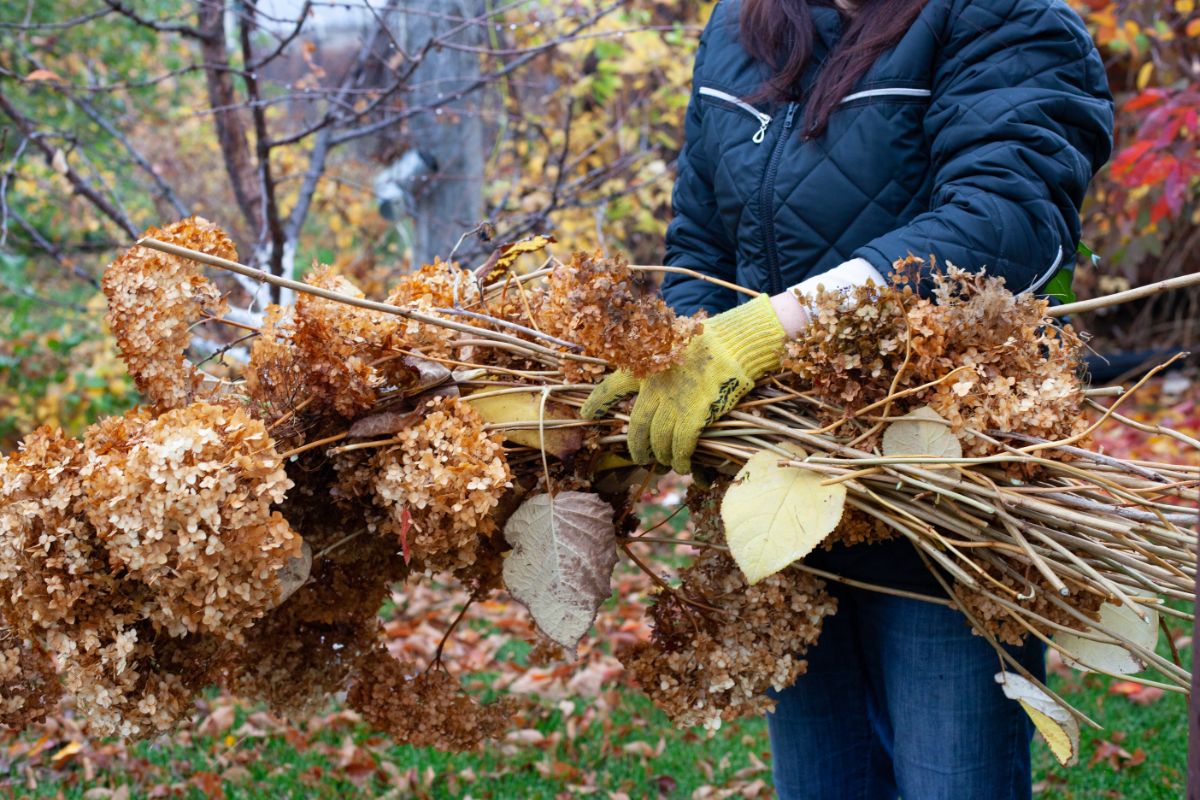
If you’ve ever hesitated with a pair of pruners, unsure whether to cut back hydrangeas in the fall or not, this guide is for you. In the 10 easy care tips below, we’ll answer all of your hydrangea pruning and autumn fertilization questions and help you set your hydrangeas up for a successful growing season to come.
Jump to:
- 10 Autumn Hydrangea Care Tips
- 1. Identify your hydrangeas.
- 2. Prune new wood hydrangeas (optional).
- 3. Harvest flowers for drying.
- 4. Clean up your shrubs.
- 5. Add fertilizer and soil amendments.
- 6. Adjust soil pH for color-changing hydrangeas.
- 7. Apply mulch.
- 8. Install winter protection.
- 9. Protect shrubs from deer.
- 10. Care for hydrangeas in containers.
- Frequently asked questions
- Summary
10 Autumn Hydrangea Care Tips
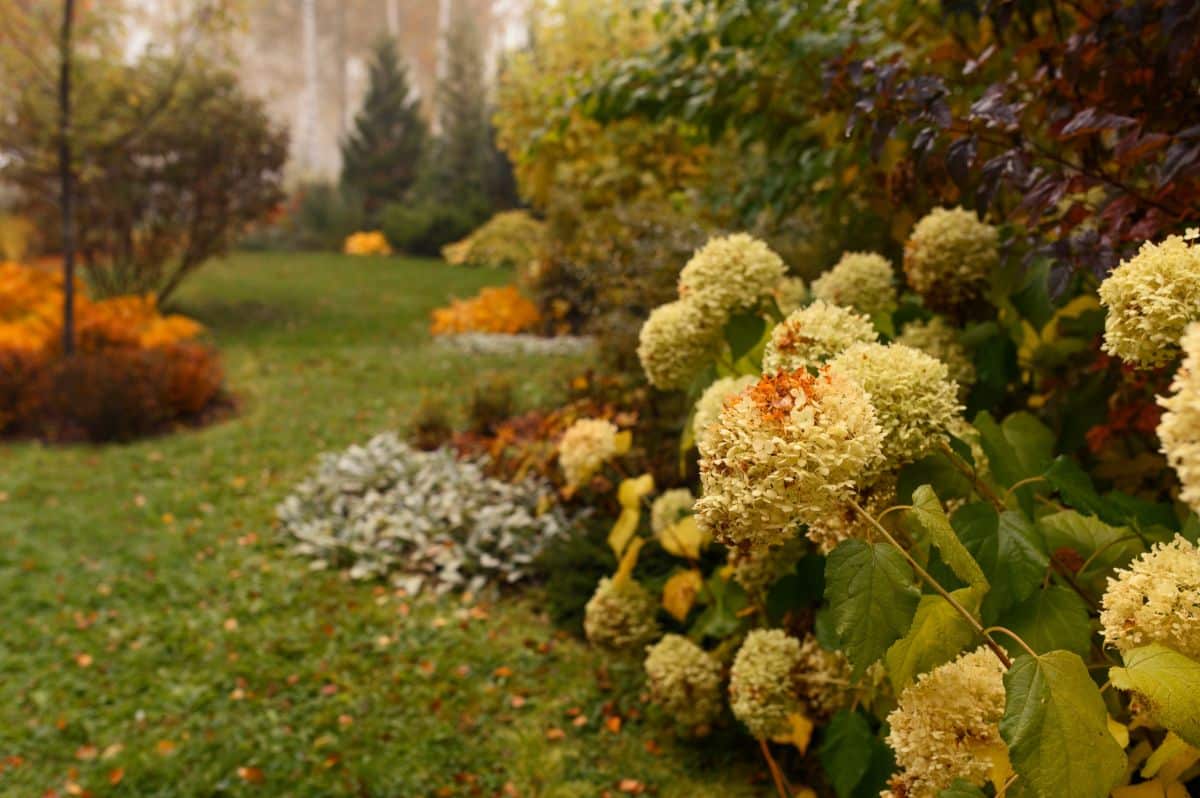
Like other perennials, hydrangeas will grow better if they receive a bit of autumn care. However, the single greatest reason why hydrangeas fail to bloom is due to “overloving” and over pruning hydrangeas in fall. So if you want your hydrangeas to grow well, it’s important to find that perfect balance between caring for them and not overdoing it!
1. Identify your hydrangeas.
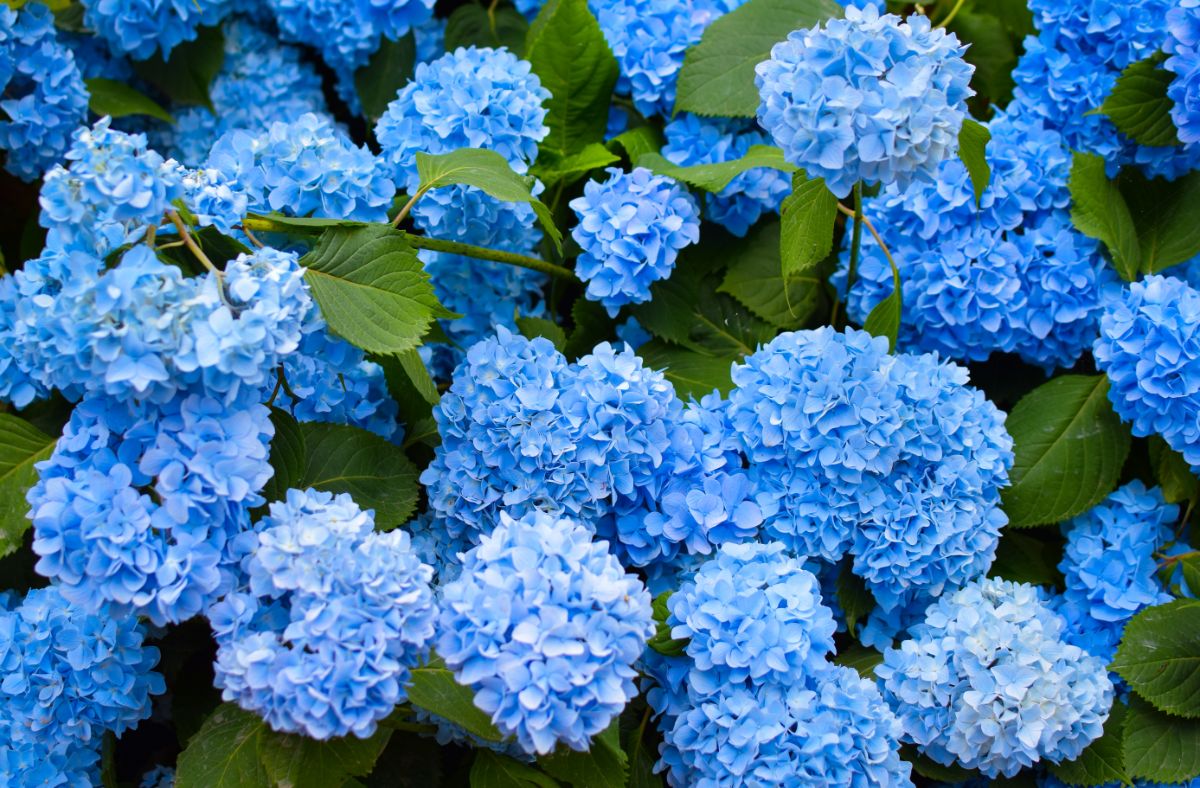
Autumn hydrangea care can be a bit confusing because there are multiple types of hydrangeas, and different cultivars have different care requirements. So if you want to care for your hydrangeas properly, it’s critical that you identify what types of hydrangeas are growing in your garden.
Hydrangeas are commonly broken down into two main categories: old wood hydrangeas and new wood hydrangeas.
New wood hydrangeas include panicle and smooth hydrangeas, and these plants flower on new growth, which makes them ultra cold hardy. However, old wood hydrangeas, including oakleaf, climbing, and most bigleaf and mountain hydrangeas, flower only on old wood, which makes these plants more susceptible to winter and pruning damage.
In the world of hydrangeas, “old wood” is defined as plant branches and stems that are at least one year old, while “new wood” stems are less than a year old. Hydrangeas that bloom on new wood can be cut back in fall or in spring, but hydrangeas that bloom on old wood should only be pruned immediately after the plant’s flowers fade in summer. That’s because pruning old wood hydrangeas in fall can remove their flower buds and prevent these plants from flowering the following year!
In an ideal world, all hydrangeas would come with pretty plant labels, and you’d never have to guess what types of hydrangeas you have, but this isn’t always the case. If you’re unsure what type of hydrangeas are growing in your garden, carefully examine the plant’s leaves and flowers for clues. For instance, panicle hydrangeas generally have conical flowers, while oakleaf hydrangeas have leaves that are shaped like the oversized leaves from oak trees!
2. Prune new wood hydrangeas (optional).

Once you’ve identified the hydrangea plants in your garden, it’s time to think about pruning your plants. Hydrangeas that bloom on old wood should never be pruned in fall, and they should only be reshaped in summer after the plant finishes flowering. However, hydrangeas that bloom on new wood can be cut back in fall or spring, depending on your gardening preferences.
If you do decide to cut back new wood hydrangeas in the fall, snip away any broken, dead, or spindly branches on your plant and clip off any branches that are touching the ground. This will clean up the lines of your plant and increase airflow, which can help to prevent fungal plant diseases. If you want to take pruning even further, you can reshape your new wood hydrangeas by clipping them into mounded forms, or you can even cut their branches down by ⅓.
Pruning new wood hydrangeas in fall is an optional step, but it can keep your garden looking trim and tidy during the winter months. That said, late winter to early spring pruning is usually recommended for new wood hydrangea types as late season pruning can make hydrangeas more vulnerable to winter damage. I usually prune my new wood hydrangeas in early spring, but if a fall pruning appeals to you, feel free to give it a go!
Tip: Reblooming hydrangea cultivars, like ‘Endless Summer,’ rarely need pruning. However, if you do need to reshape these shrubs, the best time to do it is immediately after the plant’s flowers die back.
3. Harvest flowers for drying.
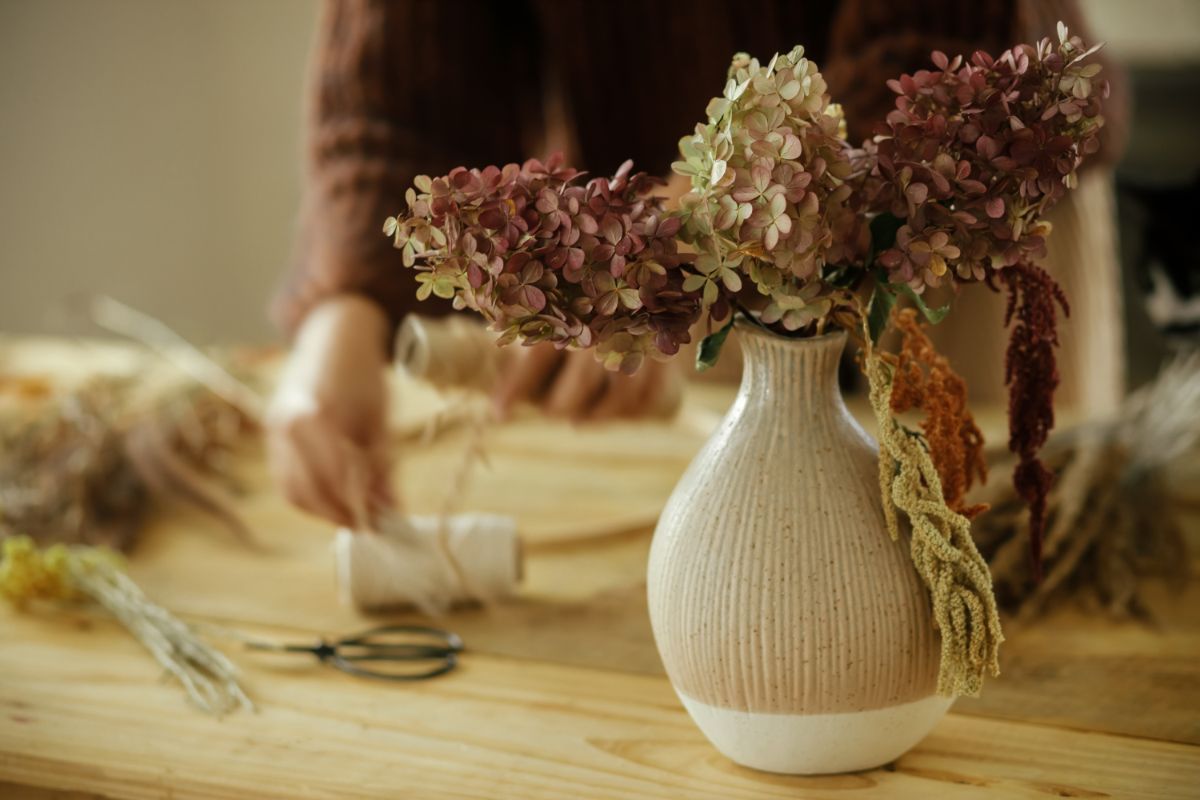
There’s no harm in leaving old hydrangea flowers on your shrubs throughout the winter months. In fact, old hydrangea flowers can look quite pretty in winter gardens when they’re all covered in snow! However, you can also clip away old hydrangea flowers in autumn if you want to make your garden look more tidy or if you want to gather hydrangea flowers for drying.
Fresh hydrangea blooms make stunning cut flower arrangements during the growing season, but these sturdy flowers make excellent dried arrangements as well. If you want to harvest hydrangea flowers for drying, you can allow the flowers to dry on the shrub for a few weeks, or you can clip the fresh flowers off and bring them indoors to dry. Snip flowers off right above the plant’s upper leaves, and be sure not to cut down too low on the stem, as this may remove some of the plant’s buds and prevent spring blooming.
After harvesting, the easiest way to dry hydrangea flowers is to place the blooms in a vase without water and allow the flowers to dry naturally indoors. You can also bundle up a few hydrangea stems with a bit of garden twine and hang them upside down to dry for a few weeks in a cool, dark, and dry place.
4. Clean up your shrubs.
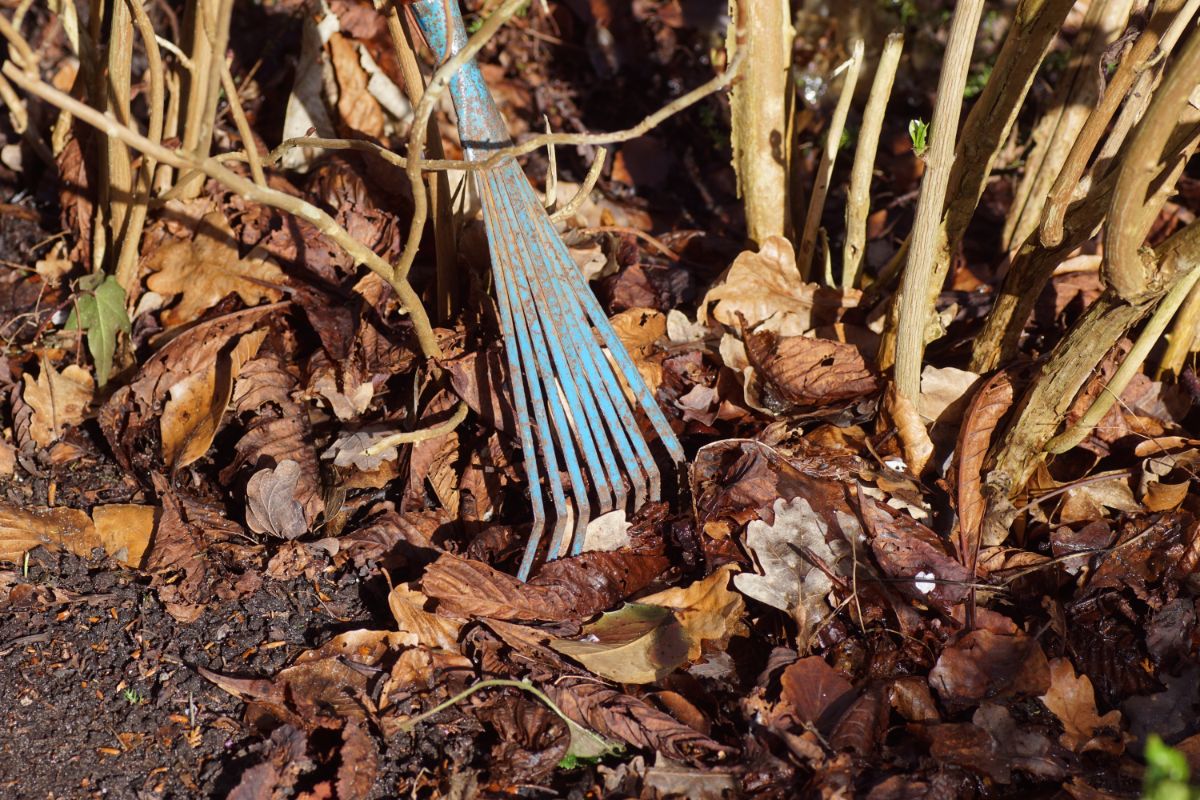
While pruning recommendations vary between hydrangea types, the majority of other autumn maintenance tips for hydrangeas are the same for both new and old wood hydrangeas. Like other plants, hydrangeas need less water in autumn and winter. But these plants can also benefit from a fall garden cleanup, which can reduce the incidence of overwintering pests and diseases and help your hydrangeas grow better in spring.
To clean up hydrangeas, use a small hand rake and rake away old leaf litter and other debris under your hydrangea shrubs. If your hydrangeas didn’t struggle with pests or diseases during the growing season, these old leaves can be added to your compost pile. However, if your hydrangeas had any pests or other problems, reduce the chances that those problems will reoccur in your spring garden by bagging and tossing old hydrangea leaves in the trash or adding them to your burn pile.
Tip: While removing plant leaves in the fall can reduce the incidence of overwintering pests and diseases, many pollinators use fallen leaves for winter shelter. For this reason, if your hydrangeas are healthy, you may want to skip this step and leave autumn leaves in place until you clean up your garden in spring.
5. Add fertilizer and soil amendments.
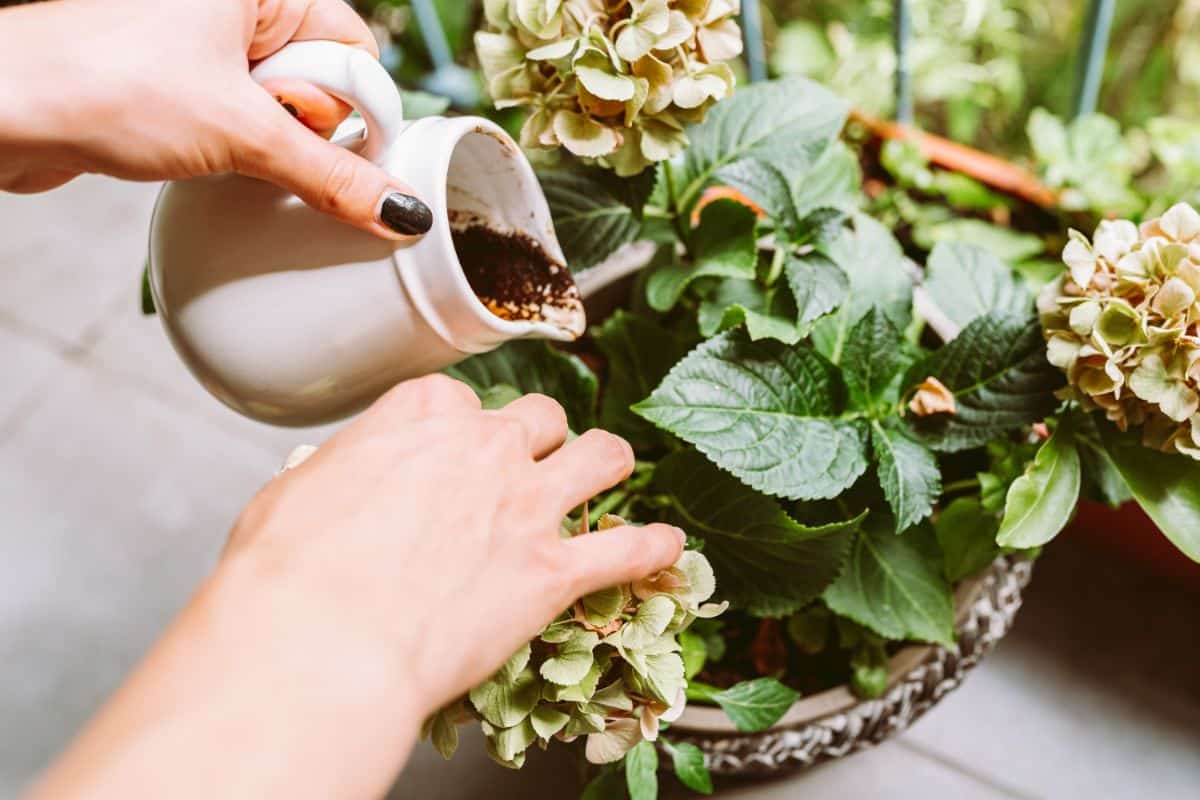
Hydrangeas may not need to be pruned in autumn, but one thing all hydrangeas will benefit from is extra nutrients! Touching up your garden beds with a bit of aged manure or compost in autumn can enrich your soil and give your hydrangeas extra nutrients for the growing season ahead. Or, if you’d prefer, you can add a slow-release granular fertilizer around the base of your plants in autumn and allow the fertilizer to naturally break down and enrich the soil over the winter.
Slow-release fertilizers, compost, and aged manure work best when applied in the fall as they take a while to break down and become incorporated into the soil. Liquid fertilizers, on the other hand, are more useful during the growing season as they are readily absorbed by plants, but they don’t last as long in garden beds.
The best time to apply fertilizer or compost to hydrangeas in the fall is in October or November, when the plant is slowing down for the year and entering into a state of dormancy. Applying fertilizers at this time can encourage hydrangeas to develop stronger root systems. However, if you fertilize plants too early in autumn, it can cause hydrangeas to leaf out late in the season and make plants more vulnerable to winter damage.
6. Adjust soil pH for color-changing hydrangeas.
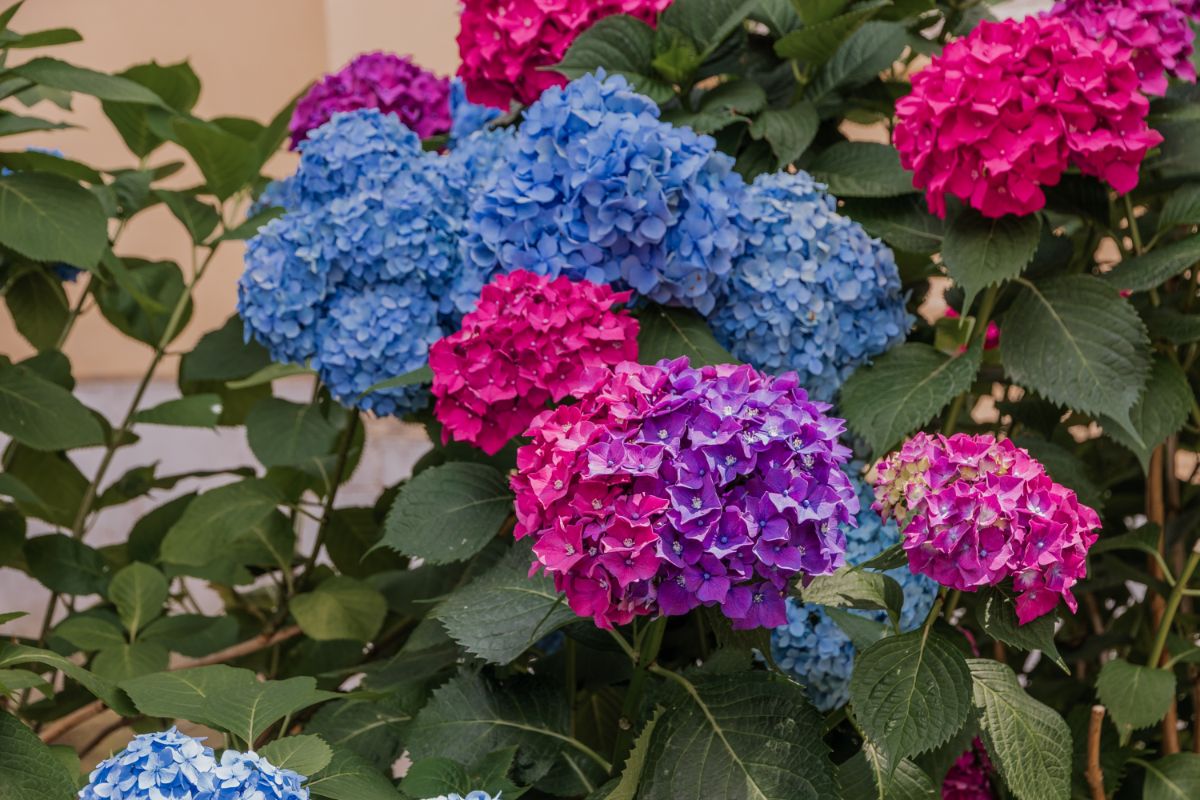
Beyond fertilizer and compost, you may also want to adjust the pH around your hydrangeas if you’re growing hydrangea types that produce different flower colors depending on soil pH levels.
Not all hydrangeas have these color-changing blooms, but many bigleaf hydrangeas (Hydrangea macrophylla) produce a rainbow of flower colors depending on their soil conditions. In acidic soils, big leaf hydrangeas bloom a brilliant blue color, but their blooms develop into warm shades of pink and purple in alkaline or neutral soils.
Although soil pH can be adjusted at different times of the year, it’s usually easiest to do it in the fall. When applied in the fall, soil acidifiers and alkalizers will have plenty of time to become incorporated into the soil, ensuring that your hydrangea blooms will be the perfect shades of pink and blue when they emerge in spring or summer. Soil acidifiers or sulfur are used to lower soil pH and turn hydrangea flowers blue, while soil alkalizers like garden lime raise soil pH and turn hydrangea blooms bubblegum pink!
7. Apply mulch.
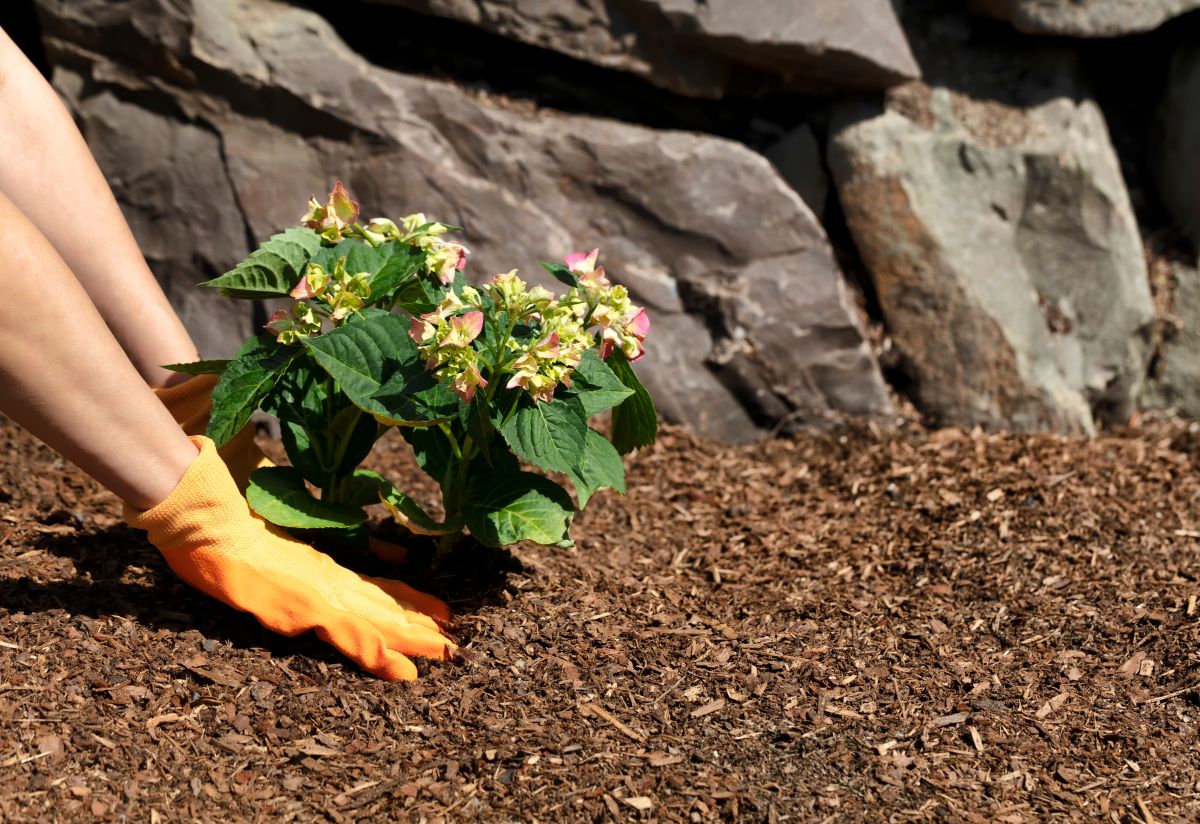
Mulch can be applied in either spring or fall, but fall is usually best. When applied at the end of the growing season, mulch will help to lock in soil moisture levels, reducing the need to water hydrangeas in autumn and winter. What’s more, a thick, 2 to 3” layer of mulch can serve as a buffer against the cold and protect sensitive hydrangea roots from winter’s chill.
Natural mulches, like bark and wood mulch, weed-free straw, and salt marsh hay, are particularly good for hydrangeas as these mulches will break down over time and enrich the soil around your plant’s roots. Pine needles and chopped autumn leaves are even more eco-friendly options for mulching if you want to lower your impact and make your garden beds even “greener.” When applying mulch, be sure to keep the mulch line several inches away from the trunk of your hydrangeas to avoid issues with mold and rot.
8. Install winter protection.
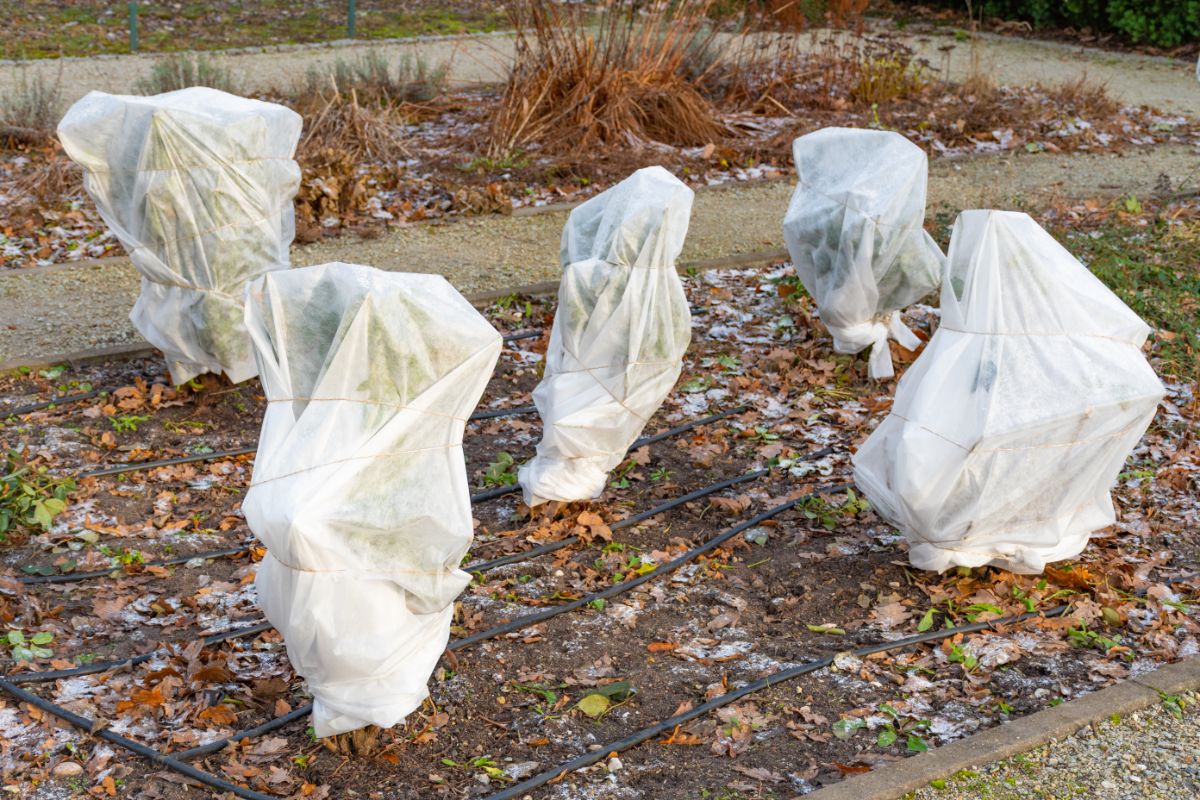
Panicle and smooth hydrangeas are famously cold-resistant, so these plants rarely need extra winter protection. But if you’re growing hydrangeas that bloom on old wood, you may want to add insulation around your plants to protect their developing flower buds. This is because old wood hydrangeas form their flower buds after they finish flowering in summer, so if these plants sustain winter damage, they may not flower the following year.
How you should go about protecting your hydrangeas will depend on your gardening style and the size of your shrubs. Shrubs can either be loosely wrapped in landscape fleece or burlap, or you can install wooden stakes around the perimeter of your shrubs, wrap burlap around the stakes, and staple it in place. If you’re using the staking method, it’s best to leave the top of your bush uncovered, as this will reduce the chances that heavy snow will crush your shrub, and snow can also provide extra insulation to your hydrangea stems.
9. Protect shrubs from deer.

Deer can target hydrangea shrubs at any time of the year. However deer damage is often worse in autumn and winter as there are fewer food resources available during these seasons. Depending on how hungry deer are, damage can be minor, or deer can destroy hydrangea branches, nibble stems down to nubs, and strip away hydrangea bark.
If you know that you have deer in your area, you may want to take extra precautions in autumn to safeguard your shrubs. If you installed burlap for winter protection, that will usually shield hydrangeas against deer as well. But you can also wrap floating row covers around your hydrangeas or spray them every 2 weeks with predator urine spray to keep deer from browsing.
Another option is to install fencing around your shrubs or garden beds, but fencing will need to be at least 8’ tall to discourage deer from jumping in and gobbling up your hydrangeas!
10. Care for hydrangeas in containers.
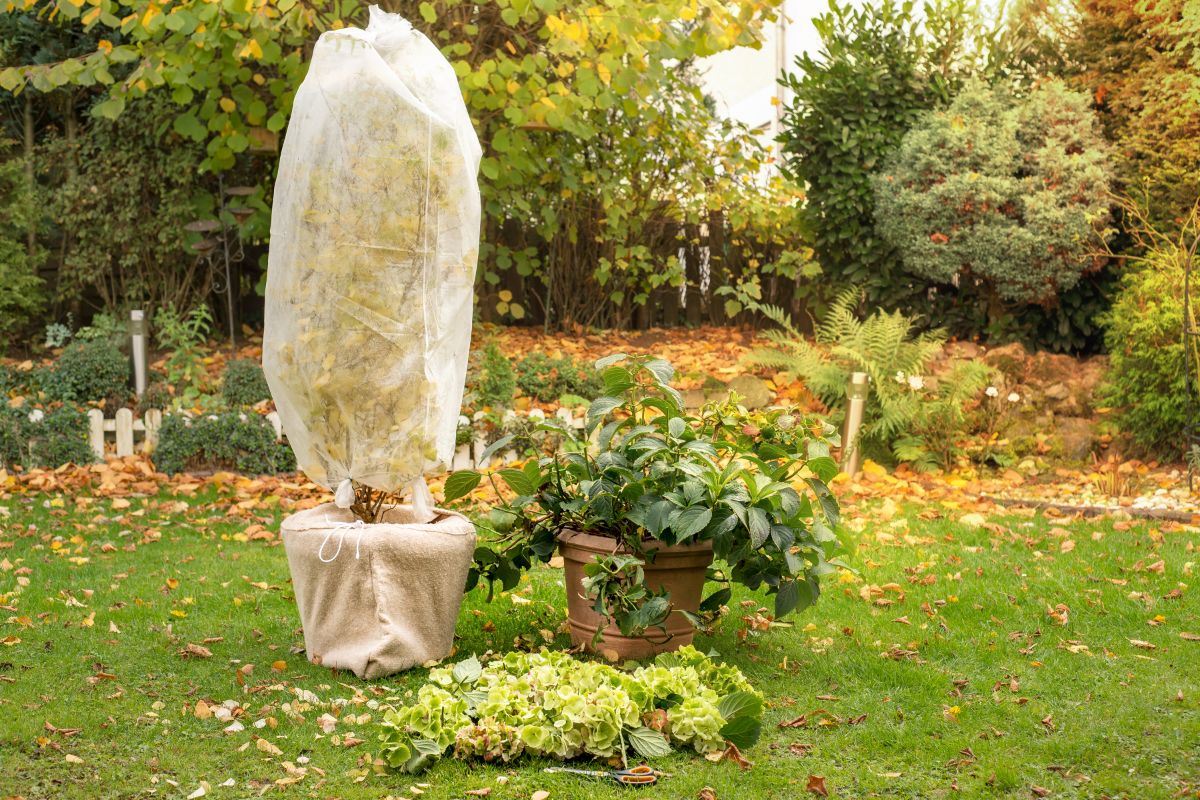
The above autumn care tips will all work well for hydrangeas planted in garden beds. But if you happen to keep dwarf hydrangeas in porch planters and other outdoor containers, there is one more step that you can take to prepare your hydrangeas for the winter ahead.
Depending on how frost-proof your hydrangea pots are, you may want to wrap your hydrangea planters in old blankets or bubble wrap to ensure they don’t crack during the winter. It’s also wise to move hydrangea planters into a protected spot in your yard or into an outbuilding or garage. As long as your hydrangeas are placed near a window, they should receive sufficient lighting, and since hydrangeas will be dormant in winter, they’ll only need to be watered lightly about once a month.
If you want to add even more protection to potted hydrangeas, consider mounding straw mulch around the base of your plants for extra insulation and wrapping floating row covers or burlap around the exterior of your plants.
Frequently asked questions
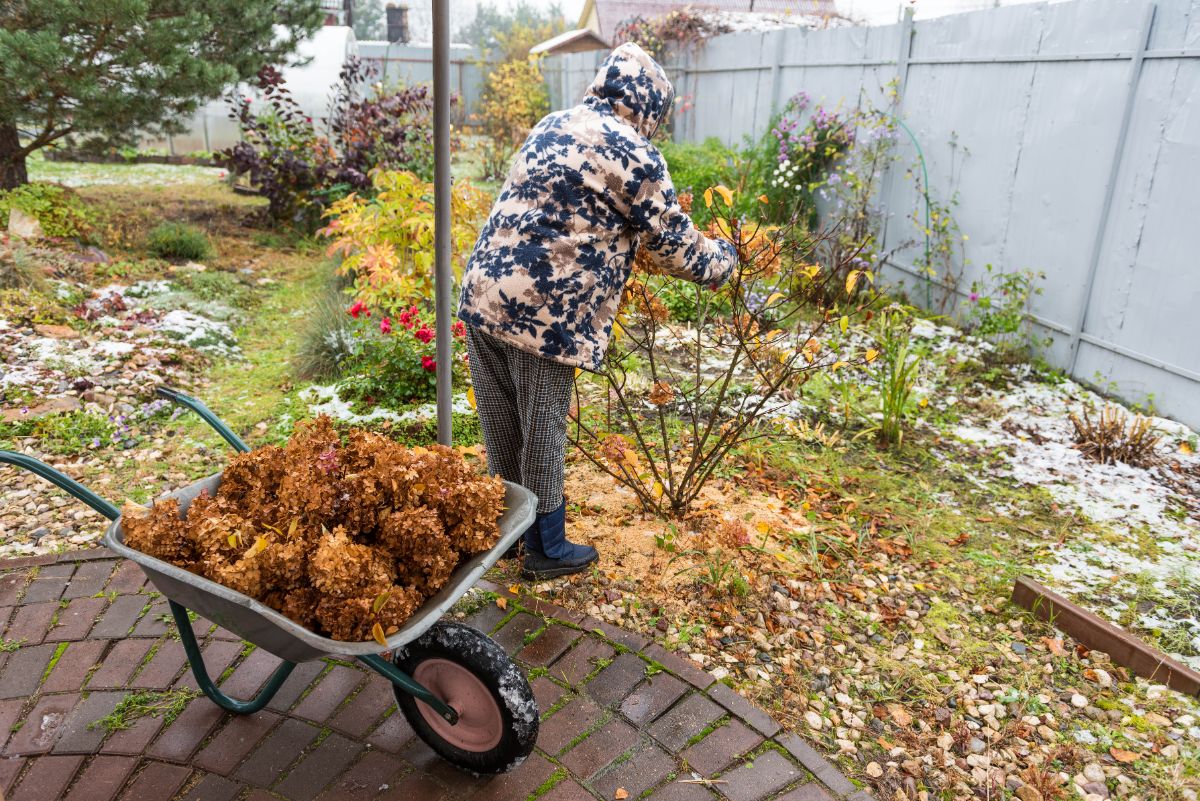
Cold hardy hydrangeas, like panicle hydrangeas, may not need any extra winter protection. However, hydrangeas that bloom on old wood may bloom better if they’re wrapped in burlap or landscape fleece before winter strikes. Adding a thick layer of mulch around the base of hydrangea bushes will also help shelter their roots from winter’s chill.
Hydrangeas that bloom on old wood should not be pruned in fall. New wood hydrangeas can be cut back by up to ⅓ in autumn, but these shrubs often grow better if they’re pruned in late winter to early spring.
While hydrangeas that bloom on new wood can be pruned in the fall, fall pruning can make plants more susceptible to winter damage. What’s more, heavy winter snow can damage the remaining branches on hydrangea shrubs, necessitating an additional spring pruning. For these reasons, it’s usually best to prune new wood hydrangeas in spring, but they can be reshaped in autumn, too, if you prefer the look of a well-manicured garden.
Nothing. While some gardeners may prefer the look of thoroughly pruned hydrangeas, there’s no harm in leaving old, spent hydrangea flowers on your shrubs throughout the winter months. Most of the time, these old flowers will fall off the plant before spring arrives anyway, and they look pretty in the snow!
Pruning hydrangeas involves cutting back or removing the plant’s stems, and hydrangeas may even be reshaped during the pruning process. Deadheading is a less invasive process in which the plant’s old flowerheads are clipped away, but the hydrangea stems are left intact.
Slow-release, granular fertilizers intended for acid-loving plants work perfectly when applied to hydrangeas in autumn. Or you can opt for compost or aged manure to improve the look and health of your hydrangeas. Hollytone is commonly used for hydrangeas, but organic fertilizers intended for roses can also be used on hydrangea shrubs.
Summary

Caring for hydrangeas in autumn can often feel a bit intimidating. However, once you understand the basic differences between old and new wood hydrangeas, it’s easy to see that these plants aren’t as complicated as they may seem.
Like many other perennials and ornamental shrubs, hydrangeas can benefit from an autumn application of mulch and slow-release fertilizer. Color-changing and cold-sensitive bigleaf hydrangeas may need their soil pH adjusted, and they may benefit from extra winter protection. But autumn pruning is often an optional process, and it should be avoided altogether on old wood hydrangeas.
We hope this article has helped to answer some of your most pressing questions on hydrangea plant care. However, if you would like to learn more about hydrangeas, we have a full guide on growing hydrangeas right here.


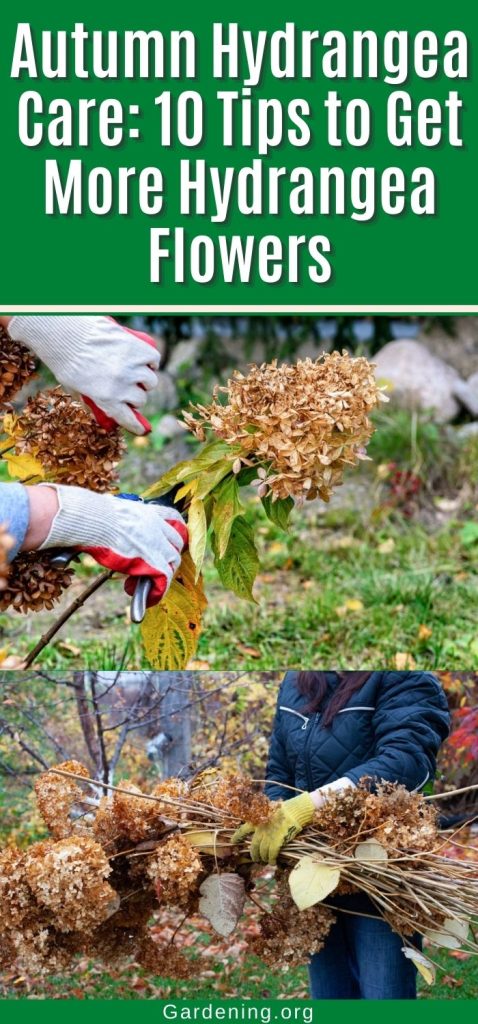






Nancy Wolfe
How can I tell what variety my hydrangeas are. I have 4 plants that I purchased at Walmart. The tag did not say the variety!
Had these a little over a year and have not had any blooms. They had lots of blooms when I purchased them!!!
Mary Ward
You'll have to do some research. There is a plant app called "Picture This" that is very good and will probably tell you (there is a free version). You could also try Google Lens.
Anita Vogt
I live in PNW. I have a hydrangea that had a pest problem this past summer. I used soap insecticide just before I left for 5 weeks. Do I prune at all or to the ground? Will the pest problem come back next spring/summer?
Mary Ward
That's very hard to say without knowing what pest you were dealing with. You might try sprinkling diatomaceous earth around the base and below the plant in case things are in the mulch or soil below. If you feel like you got a hold of the pests, I would follow the best pruning practices for the type of hydrangea your have. You could do a final fall spray as insurance. Neem oil wouldn't hurt. And possibly a dormant horticultural spray or neem in the spring before bud break in case any over wintered. I personally would lean toward treating the pests rather than pruning a bush that doesn't need it.